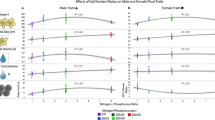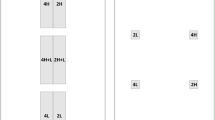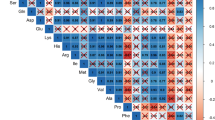Abstract
Floral traits have evolved to maximize reproductive success by attracting pollinators and facilitating pollination. Highly attractive floral traits may, however, also increase the degree of self-pollination, which could become detrimental for plant fitness through inbreeding depression. Floral nectar is a trait that is known to strongly mediate pollinator attraction and plant reproductive success, but the particular role of the nectar amino acid (AA) composition is poorly understood. Therefore, we experimentally manipulated the nectar AA composition and abundance of the Lepidoptera-pollinated orchid Gymnadenia conopsea through soil fertilization, and we quantified AA content and AA composition through high performance anion exchange chromatography with pulsed amperometric detection. Mixed models were then used to evaluate differences in pollinia removal, fruit set, seed set and degree of selfing between fertilized and control individuals. Selfing rates were estimated using microsatellite markers. We found that fertilized individuals had a significantly higher nectar AA content and an altered AA composition, whereas plant height, number of flowers, nectar volume and sugar concentration remained unchanged. Fertilized individuals also had significantly more pollinia removed and a higher fruit set, whereas control plants that did not receive the fertilization treatment had significantly fewer selfed seeds, and more viable seeds. Although we cannot exclude a role of changes in floral scent following the fertilization treatment, our results strongly suggest a relation among nectar AA composition, fruiting success and selfing rates. Our results also indicate potential consequences of nutrient pollution for plant reproductive success, through the induced changes in nectar AA composition.



Similar content being viewed by others
References
Adriaens D, Honnay O, Hermy M (2006) No evidence of a plant extinction debt in highly fragmented calcareous grasslands in Belgium. Biol Conserv 133:212–224
Alm J, Ohnmeiss TE, Lanza J, Vriesenga L (1990) Preference of cabbage white butterflies and honey bees for nectar that contains amino acids. Oecologia 84:53–57
Baker PHG, Baker I (1986) The occurrence and significance of amino acids in floral nectar. Plant Syst Evol 151:175–186
Barrett SCH (2002) Evolution of sex: the evolution of plant sexual diversity. Nat Rev Genet 3:274–284
Bertazzini M, Medrzycki P, Bortolotti L, Maistrello L, Forlani G (2010) Amino acid content and nectar choice by forager honeybees (Apis mellifera L.). Amino Acids 39:315–318
Burkle LA, Irwin RE (2010) Beyond biomass: measuring the effects of community-level nitrogen enrichment on floral traits, pollinator visitation and plant reproduction. J Ecol 98:705–717
Ceulemans T, Stevens CJ, Duchateau L, Jacquemyn H, Gowing DJG, Merckx R, Wallace H, van Rooijen N, Goethem T, Bobbink R, Dorland E, Gaudnik C, Alard D, Corcket E, Muller S, Dise NB, Dupré C, Diekmann M, Honnay O (2014) Soil phosphorus constrains biodiversity across European grasslands. Glob Change Biol 12:3814–3822
Cresswell JE (1999) The influence of nectar and pollen availability on pollen transfer by individual flowers of oil-seed rape (Brassica napus) when pollinated by bumblebees (Bombus lapidarius). J Ecol 87:670–677
Darwin C (1862) On the various contrivances by which British and foreign orchids are fertilised by insects: and on the good effects of intercrossing. Murray, London
Davis MA (1981) The effect of pollinators, predators, and energy constraints on the floral ecology and evolution of Trillium erectum. Oecologia 48:400–406
De Jong TJ, Waser NM, Klinkhamer PGL (1993) Geitonogamy: the neglected side of selfing. Trends Ecol Evol 8:321–325
Dudash MR (1991) Plant size effects on female and male function in hermaphroditic Sabatia angularis (Gentianaceae). Ecology 72:1004–1012
Fournier DA, Skaug HJ, Ancheta J, Ianelli J, Magnussen A, Maunder MN, Nielsen A, Sibert J (2012) AD Model Builder: using automatic differentiation for statistical inference of highly parameterized complex nonlinear models. Optim Methods Softw 27:233–249
Galen C, Newport MEA (1987) Bumble bee behavior and selection on flower size in the sky pilot, Polemonium viscosum. Oecologia 74:20–23
Gardener MC, Gillman MP (2001) The effects of soil fertilizer on amino acids in the floral nectar of corncockle, Agrostemma githago (Caryophyllaceae). Oikos 92:101–106
Gardener MC, Gillman MP (2002) The taste of nectar—a neglected area of pollination ecology. Oikos 98:552–557
Gijbels P, Van den Ende W, Honnay O (2014) Landscape scale variation in nectar amino acid and sugar composition in a Lepidoptera pollinated orchid species and its relation with fruit set. J Ecol 102:136–144
Gijbels P, Van den Ende W, Honnay O (2015) Phenotypic selection on nectar amino acid composition in the Lepidoptera pollinated orchid species Gymnadenia conopsea. Oikos 124:421–427
González-Teuber M, Heil M (2009) Nectar chemistry is tailored for both attraction of mutualists and protection from exploiters. Plant Signal Behav 4:809–813
Goodwillie C, Kalisz S, Eckert CG (2005) The evolutionary enigma of mixed mating in plants: occurrence, theoretical explanations, and empirical evidence. Annu Rev Ecol Evol Syst 35:47–79
Gross K, Schiestl FP (2015) Are tetraploids more successful? Floral signals, reproductive success and floral isolation in mixed-ploidy populations of a terrestrial orchid. Ann Bot 115:263–273
Güsewell S, Koerselman W (2002) Variation in nitrogen and phosphorus concentrations of wetland plants. Perspect Plant Ecol Evol Syst 5:37–61
Gustafsson S (2000) Patterns of genetic variation in Gymnadenia conopsea, the fragrant orchid. Mol Ecol 9:1863–1872
Hair JF, Black WC, Babin BJ, Anderson RE (2009) Multivariate data analysis, 7th edn. Prentice Hall, Englewood Cliff
Harder LD, Barrett SCH (1995) Mating cost of large floral displays in hermaphrodite plants. Nature 373:512–515
Hodges SA (1995) The influence of nectar production on hawkmoth behavior, self pollination, and seed production in Mirabilis multiflora (Nyctaginaceae). Am J Bot 82:197–204
Huber FK, Kaiser R, Sauter W, Schiestl FP (2005) Floral scent emission and pollinator attraction in two species of Gymnadenia (Orchidaceae). Oecologia 142:564–575
Irwin RE, Adler LS (2008) Nectar secondary compounds affect self-pollen transfer: implications for female and male reproduction. Ecology 89:2207–2217
Iwata T, Nagasaki O, Ishii HS, Ushimaru A (2012) Inflorescence architecture affects pollinator behaviour and mating success in Spiranthes sinensis (Orchidaceae). New Phytol 193:196–203
Jersáková J, Johnson SD (2006) Lack of floral nectar reduces self-pollination in a fly-pollinated orchid. Oecologia 147:60–68
Jervis M, Boggs C (2005) Linking nectar amino acids to fitness in female butterflies. Trends Ecol Evol 20:585–587
Johnson SD, Nilsson LA (1999) Pollen carryover, geitonogamy, and the evolution of deceptive pollination systems in orchids. Ecology 80:2607–2619
Johnson SD, Peter CI, Agren J (2004) The effects of nectar addition on pollen removal and geitonogamy in the non-rewarding orchid Anacamptis morio. P Roy Soc Lond B Bio 271:803–809
Keller L (2002) Inbreeding effects in wild populations. Trends Ecol Evol 17:230–241
Lajtha K, Driscoll CT, Jarrell WM, Elliott ET (1999) Soil phosphorus. Characterization and total element analysis. In: Robertson GP, Coleman DC, Bledsoe CS, Sollins P (eds) Standard soil methods for long-term ecological research. Oxford University Press, New York, pp 115–142
Mamut J, Xiong YZ, Tan DY, Huang SQ (2014) Pistillate flowers experience more pollen limitation and less geitonogamy than perfect flowers in a gynomonoecious herb. New Phytol 201:670–677
Manson JS, Cook D, Gardner DR, Irwin RE (2013) Dose-dependent effects of nectar alkaloids in a montane plant-pollinator community. J Ecol 101:1604–1612
Meekers T, Honnay O (2011) Effects of habitat fragmentation on the reproductive success of the nectar-producing orchid Gymnadenia conopsea and the nectarless Orchis mascula. Plant Ecol 212:1791–1801
Meekers T, Hutchings MJ, Honnay O, Jacquemyn H (2012) biological flora of the British Isles: Gymnadenia conopsea s.l. J Ecol 100:1269–1288
Mevi-Schütz J, Erhardt A (2005) Amino acids in nectar enhance butterfly fecundity: a long-awaited link. Am Nat 165:411–419
Meyer B, Kröger J, Steffan-Dewenter I (2007) Contribution of diurnal and nocturnal pollinators to the reproductive success of the Orchid species Gymnadenia conopsea. Entomol Gener 30: 299–300
Nepi M (2014) Beyond nectar sweetness: the hidden ecological role of non-protein amino acids in nectar. J Ecol 102:108–115
Nicolson SW, Thornburg RW (2007) Nectar chemistry. In: Nicolson W, Nepi M, Pacini E (eds) Nectaries and nectar. Springer, the Netherlands, pp 215–264
Ollerton J, Winfree R, Tarrant S (2011) How many flowering plants are pollinated by animals? Oikos 120:321–326
Peter CI, Johnson SD (2006) Doing the twist: a test of Darwin’s cross-pollination hypothesis for pollinarium reconfiguration. Bio Lett 2:65–68
Pyke GH (1991) What does it cost a plant to produce floral nectar? Nature 350:58–59
R Core Team (2014) R: A language and environment for statistical computing. R Foundation for Statistical Computing, Vienna. http://www.R-project.org/
Raguso RA (2004) Why are some floral nectars scented? Ecology 85:1486–1494
Robertson P, Coleman D, Bledsoe C, Sollins P (1999) Standard soil methods for long-term ecological research. Oxford University Press, London
Rodríguez-Peña N, Stoner KE, Ayala-Berdon J, Flores-Ortiz CM, Duran A, Schondube JE (2013) Nitrogen and amino acids in nectar modify food selection of nectarivorous bats. J Anim Ecol 82:1106–1115
Schiestl FP (2015) Ecology and evolution of floral volatile-mediated information transfers in plants. New Phytol 206:571–577
Shiraishi A, Kuwabara M (1970) The effects of amino acids on the labellar hair chemo-sensory cells of the fly. J Gen Physiol 56:768–782
Sletvold N, Trunschke J, Wimmergren C, Ågren J (2012a) Separating selection by diurnal and nocturnal pollinators on floral display and spur length in Gymnadenia conopsea. Ecology 93:1880–1891
Sletvold N, Grindeland JM, Zu P, Ågren J (2012b) Strong inbreeding depression and local outbreeding depression in the rewarding orchid Gymnadenia conopsea. Cons Genet 13:1305–1315
Stevens CJ, Duprè C, Dorland E, Gaudnik C, Gowing DJG, Bleeker A, Diekmann M, Alard D, Bobbink R, Fowler D, Corcket E, Mountford JO, Vandvik V, Aarrestad PA, Muller S, Dise NB (2010) Nitrogen deposition threatens species richness of grasslands across Europe. Environ Pollut 158:2940–2945
Tilman D, Fargione J, Wolff B, D’Antonio C, Dobson A, Howarth R, Schindler D, Schlesinger WH, Simberloff D, Swackhamer D (2001) Forecasting agriculturally driven global environmental change. Science 292:281–284
Acknowledgments
P. G. and T. C. were funded by the Research Foundation Flanders. This project was financed through a KU Leuven BOF-OT grant. The authors thank Gert Verheyen, Timmy Reijnders and Rudy Vergauwen who assisted with field and lab work and high performance anion exchange chromatography with pulsed amperometric detection analysis. We thank the anonymous reviewers and handling editor M. Kant for detailed comments that greatly improved the manuscript.
Data accessibility
All data will be made available on DRYAD.
Author information
Authors and Affiliations
Corresponding author
Additional information
Communicated by Merijn Kant.
Electronic supplementary material
Below is the link to the electronic supplementary material.
Rights and permissions
About this article
Cite this article
Gijbels, P., Ceulemans, T., Van den Ende, W. et al. Experimental fertilization increases amino acid content in floral nectar, fruit set and degree of selfing in the orchid Gymnadenia conopsea . Oecologia 179, 785–795 (2015). https://doi.org/10.1007/s00442-015-3381-8
Received:
Accepted:
Published:
Issue Date:
DOI: https://doi.org/10.1007/s00442-015-3381-8




